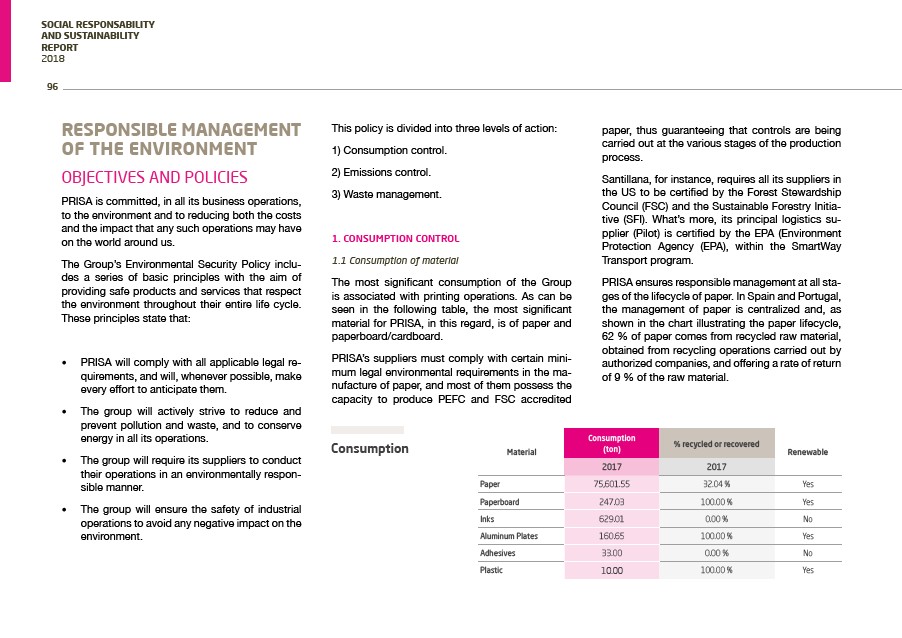
96 SOCIAL RESPONSABILITY
AND SUSTAINABILITY
REPORT
2018
RESPONSIBLE MANAGEMENT
OF THE ENVIRONMENT
OBJECTIVES AND POLICIES
PRISA is committed, in all its business operations,
to the environment and to reducing both the costs
and the impact that any such operations may have
on the world around us.
The Group’s Environmental Security Policy includes
a series of basic principles with the aim of
providing safe products and services that respect
the environment throughout their entire life cycle.
These principles state that:
• PRISA will comply with all applicable legal requirements,
and will, whenever possible, make
every effort to anticipate them.
• The group will actively strive to reduce and
prevent pollution and waste, and to conserve
energy in all its operations.
• The group will require its suppliers to conduct
their operations in an environmentally responsible
manner.
• The group will ensure the safety of industrial
operations to avoid any negative impact on the
environment.
This policy is divided into three levels of action:
1) Consumption control.
2) Emissions control.
3) Waste management.
1. CONSUMPTION CONTROL
1.1 Consumption of material
The most significant consumption of the Group
is associated with printing operations. As can be
seen in the following table, the most significant
material for PRISA, in this regard, is of paper and
paperboard/cardboard.
PRISA’s suppliers must comply with certain minimum
legal environmental requirements in the manufacture
of paper, and most of them possess the
capacity to produce PEFC and FSC accredited
paper, thus guaranteeing that controls are being
carried out at the various stages of the production
process.
Santillana, for instance, requires all its suppliers in
the US to be certified by the Forest Stewardship
Council (FSC) and the Sustainable Forestry Initiative
(SFI). What’s more, its principal logistics supplier
(Pilot) is certified by the EPA (Environment
Protection Agency (EPA), within the SmartWay
Transport program.
PRISA ensures responsible management at all stages
of the lifecycle of paper. In Spain and Portugal,
the management of paper is centralized and, as
shown in the chart illustrating the paper lifecycle,
62 % of paper comes from recycled raw material,
obtained from recycling operations carried out by
authorized companies, and offering a rate of return
of 9 % of the raw material.
Material
Consumption
(ton)
% recycled or recovered
Renewable
2017 2017
Paper 75,601.55 32.04 % Yes
Paperboard 247.03 100.00 % Yes
Inks 629.01 0.00 % No
Aluminum Plates 160.65 100.00 % Yes
Adhesives 33.00 0.00 % No
Plastic 10.00 100.00 % Yes
Consumption